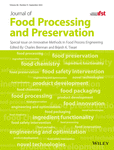Optimization of process parameters for ultrasound-assisted osmotic dehydration of pineapple slices using response surface methodology
Abstract
The effect of ultrasound-assisted osmotic dehydration (USOD) on dehydration kinetics viz., water loss (WL), solid gain (SG), and osmotic dewatering rate (ODR) was investigated using response surface methodology, in order to optimize process parameters. Pineapple slices were subjected to USOD at three different osmotic solution concentrations (50, 60, and 70°B), sonication time (20, 30, and 40 min), and temperatures (10, 20, and 30°C) using two types of osmotic agents (glucose and fructose) in an ultrasonic bath (ultrasound frequency of 33 ± 3 kHz and ultrasound power of 250 W). Box–Behnken design was used as experimental design, consisting of three factors with three levels, and a categoric factor with two levels, totaling 34 data points. Results of ANOVA and regression analysis conducted showed significant effects on responses and model's best fit to the experimental data. Results revealed that USOD treatment led to higher water loss and osmotic dewatering rate compared to osmotic dehydration (OD). The optimized values that would give maximum WL, ODR, and minimum SG were osmotic solution concentration of 50°B, sonication time of 26.6 min, temperature of 30°C, and using fructose as osmotic agent. This resulted in values of 0.266 g water/g, 0.049 g solid/g, and 0.730 g/min for water loss, solid gain, and osmotic dewatering rate, respectively.
Practical applications
USOD is a non-thermal process and could be a novel technology in food processing and preservation. Application of ultrasonic waves during osmotic dehydration enhanced the water loss and dewatering rate, due to the synergistic effect of osmotic pressure gradient and generation of microscopic channels caused by cavitation (ultrasonic effect). USOD can remove upto 26.6% of water from the fresh pineapples in 26.6 min of sonication time, using fructose as osmotic agent at 50°B and temperature of 30°C therefore, maybe considered as a promising method for the production of partially dried product.
CONFLICT OF INTEREST
The authors have declared no conflict of interest to this article.
Open Research
DATA AVAILABILITY STATEMENT
The data that supports the findings of this study are available in Meena et al. (2022).




